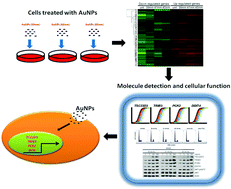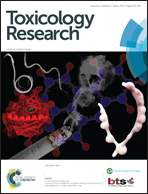A gene signature for gold nanoparticle-exposed human cell lines†
Abstract
There is currently a significant need for effective methods aimed at diagnosing and screening for nanoparticle exposure. We previously investigated the toxicity of three different particle sized gold nanoparticles (AuNPs) toward different types of mammalian cells and explored a related gene expression profile by cDNA microarray analysis of AuNP-exposed MRC-5 cells. In this study, we sought to further identify genes that could be used as biomarkers for AuNP exposure. We used cDNA microarray analysis to obtain comprehensive gene expression profiles from A549 cells exposed to three different-sized AuNPs. A total of 409 genes were commonly up-regulated by the tested AuNPs; of them, 71 had previously been analyzed to be up-regulated in MRC-5 cells. Among the top-ranked 30 of these 71 up-regulated genes, based on the magnitude of induction, nine genes were confirmed to be transcriptionally induced in A549 cells by all three tested AuNPs, as assessed by quantitative real-time polymerase chain reaction (qPCR). Among them, TSC22D3, TRIB3, PCK2 and DDIT4 were the most sensitive to the three AuNPs, and showed dose-dependent changes in several human cell lines. qPCR and immunoblotting analyses revealed that the same concentrations of micro-Au and nano-TiO2 failed to elicit up-regulation of these four genes at the mRNA and protein levels in any tested cell lines. Although the definition and practical implementation of specific biomarkers for nanoparticles is still in its infancy, our data suggest that it may be possible to define reliable biomarkers for the diagnosis of nanomaterial exposure.

- This article is part of the themed collection: Nanotoxicology

 Please wait while we load your content...
Please wait while we load your content...